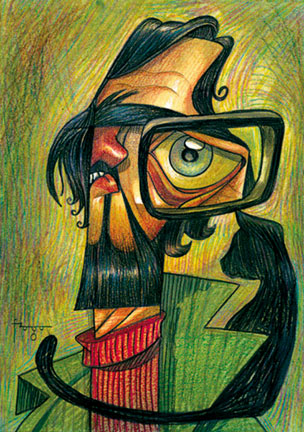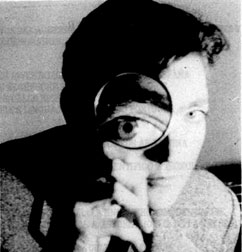Rayuela by Julio Cortázar - A contemporary of Gabriel Garcia Marquez


Carricature of Julio Cortazar
Rayuela |
'Rayuela' is a novel by Argentine author Julio Cortázar. It was
written in Paris and published in Spanish in 1963 and in English in
1966. Like Gabriel Garcia Marquez's 'Cien anos de soledad', the novel
falls firmly into the category of a Boom novel. Rayuela means Hopscotch
in English, which is very apt, given the structure of the novel.
Written in an episodic, snapshot manner, the novel has 155 chapters,
the last 99 being designated as "expendable." The book can be read
either in direct sequence from chapter 1 to 56, which, Cortázar writes,
the reader can do "with a clean conscience", or by skipping randomly
through the entire set of 155 chapters-except chapter 55-according to a
table provided by the author that leaves the reader, finally, in an
infinite loop between the last two chapters in the sequence. There are
several other ways to read the novel, such as reading only the odd or
even pages, or choosing chapters in completely random order. Some of the
"expendable" chapters fill in gaps in the main story, while others add
information about the characters or record the aesthetic and literary
speculations of a writer named Morelli (arguably a stand-in for the
author) who makes a brief appearance in the narrative. The novel is an
example of multiple endings.
Narration is an important part of the structure of the book.
Initially it seems clear that Horacio is the narrator and the 'writer'
of the story, especially since it is repeatedly implied that La Maga is
his muse and eventual literary salvation. However later the introduction
of Morelli as a character seems to hint that he is the true writer of
the story. Especially in the 'Morelliana' of the expendable chapters,
Cortázar makes clear that Morelli is the talented writer and the one who
could achieve success if only he could escape the cages of his life.
Morelli as author also makes more sense since the chapters seem to
randomly switch back and forth between first person for Horacio, third
person limited for any number of characters and occasionally third
person omniscient. This novel is often referred to as a counter-novel,
even by Cortázar himself.
As the first book opens, Horacio Oliveira, the narrator, is wandering
the bridges of Paris alone one afternoon. He observes the various
happenings around him and considers how different Paris is from his
native Argentina. That evening he meets up with his lover, Lucía (most
often referred to as La Maga in the book), and the two of them wander
Paris together. That evening they meet up with their friends, a group
affectionately referred to as 'The Serpent Club,' as they do almost
every night. The Club passes the time drinking heavily, dissecting
literature and philosophy and listening to jazz records.
During their late-night discussions, they meander their way from
subject to subject with ease. Though Horacio is the newest addition to
the group, he is easily the most well-versed in literature and in
philosophy, surpassing even the arrogant Gregorovius Ossip. All the
members have their strengths and weaknesses, generally based on their
nationalities. However, unlike Horacio and the other members of the
Club, La Maga is neither well-read nor articulate and she often needs
the others to explain concepts to her. Her insistence on staying in the
realm of reality while the others deal primarily with abstracts
distances her from the group and foreshadows her eventual disappearance.
|

Julio Cortazar |
The second book opens with an introduction to the life of Manolo
Traveler, a great friend of Horacio, who lives in Buenos Aires with his
wife Talita, a pharmaceutical assistant. Traveler is disappointed about
his name because he almost didn't travel at all in is whole life.
Horacio comes back to Buenos Aires only to find that Traveler is waiting
for him at the docks with his wife, and after greeting him and having
lunch, he decides to settle near Traveler. He slowly starts to observe
his friend's lifestyle, and realizes that Talita subtly reminds him of
La Maga. This forces a metaphysical triangle between the three of them,
where Horacio and Traveler seem to be always brawling about Talita in
their complicated and poetic way. During this time, Horacio realizes he
is in love with La Maga.
One night Horacio is smoking at his window, when he sees Talita
crossing the garden, going to sleep. She disappears, and suddenly La
Maga comes out of nowhere and starts playing hopscotch in the
institution's garden. Later, when Horacio is guarding the second floor,
he starts to get obsessed with the idea of getting killed by Traveler.
Talita appears then, with a glass of lemonade. They start talking and
Horacio tells her about seeing La Maga/Talita playing in the garden, and
she confesses to dislike hopscotch, and admits she felt suddenly
interested in playing. Then the elevator starts working and they prepare
to resist whoever comes, but it turns to be a lunatic that was taking
his pigeon out for a walk. So they decide to go to the basement, where
the lunatic came from, to verify that everything is alright. When they
are there, Horacio starts to daydream about La Maga, confuses her with
Talita and so he kisses his friend's wife. Later that night, Talita
tells Traveler about that kiss but he doesn't seem to be angry. At the
same time, Horacio is obsessed with the idea of Traveler killing him, so
he starts building a "defense line" with water-filled basins and a huge
skein of colorful threads.
When he finishes, he sits near the window and begins to smoke. Soon
he sees Talita below the window, and feels the defense line he has set
up stopping Traveler. The two begin to talk about their duality and
relationship, about Horacio himself and about society. Eventually there
is a wonderful harmony of the moment, and Horacio thinks that given the
circumstances, it would be the best time to commit suicide. The ending
is ambiguous as to whether he does or not if only reading the first 56
chapters. Reading the so-called expendable chapters then offer further
insight.
The main character, Horacio Oliveira, is a well-read and loquacious
bohemian. He is a spectator and spends most of his time philosophizing.
He is always finding metaphysics in all of his speeches. At first it
seems Horacio is content merely to exist but really he is desperately
searching for a purpose to his life. He always is meditating about the
so called 'centre', the real meaning and purpose of life. He explains it
is not a geographical centre, because this would be absurd, but a
metaphysical centre.
For lack of an alternative, La Maga becomes Horacio's life-purpose.
She is a beguiling, profound, and improvisational woman. La Maga
develops into a muse and a lens for Horacio-inspiring him to examine
himself and Paris more thoroughly. She is a point of origin for Horacio
and the novel itself.
Some of the main themes in the novel are:-
Order verses chaos: Horacio says of himself, "I imposed the false
order that hides the chaos, pretending that I was dedicated to a
profound existence while all the time it was the one that barely dipped
its toe into the terrible waters". Horacio's life follows this
description as he switches countries, jobs, and lovers. The novel also
attempts to resemble order while ultimately consisting of chaos.
Cortázar does the same by using a loose form of prose, rich in metaphor
and slang to describe life.
Horacio verses society: Horacio drifts from city to city, job to job,
love to love, life to life, yet even in his nomadic existence he tries
to find a sense of order in the world's chaos. He is always isolated:
when he is with La Maga, he cannot relate to her; when he is with the
Club, he is superior. When he is with Traveler and Talita he fights
their way of life. Even with Morelli, the character he relates to most,
there are barriers of the patient and orderly. Order versus chaos also
exists in the structure of the novel, as in Morelli's statement, "You
can read my book any way you want to".
Isolation and loneliness: Cortázar uses a quick, succinct, vignette
chapter style that paints brief images for the reader without relying
too much on plot. At one point in the novel Horacio witnesses a car
accident. It is said of the victim that "he doesn't have any family,
he's a writer." Horacio is stunned by the way violence brings the
community together. Medics rush to the scene in an ambulance and speak
"friendly, comforting words to him." Violence and conflict continually
bring characters together . For instance, Talita's crossing of the
bridge and Horacio's stunt at the conclusion of the novel..
The definition of failure: Horacio's life seems hopeless because he
has deemed himself a failure. The short chapters also express the idea
that there is no penetrating purpose to the novel and life in general.
For Horacio, life is a series of artistic flashes where he perceives the
world in a profound way but still remains unable to create anything of
value. Other major themes include obsession, madness, life-as-a-circus,
the nature and meaning of sex and self-knowledge.
In my opinion Cortazar is one of the best writers of the late 60's
Latin American Boom. He penned not only some of the most well-crafted
short stories i have ever read but a novel that you can read from start
to finish or in a pattern of suggested chapters which creates another
novel. Brilliant? You should read it and decide. |

